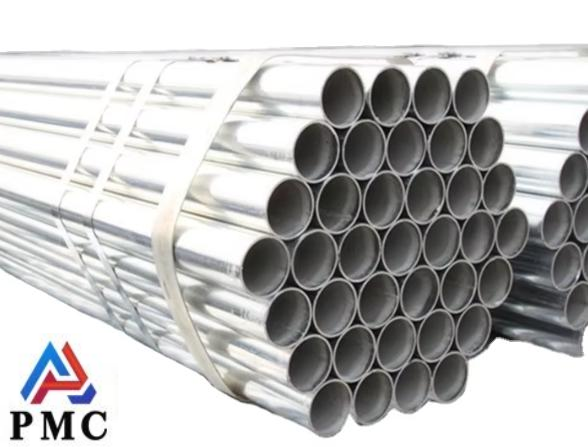
Wall Thickness Specification of Galvanized Steel Pipes
Galvanized steel pipe is a welded steel pipe with a hot-dip or electroplated zinc layer on the surface. Galvanizing can increase the corrosion resistance of steel pipes and extend their service life. Galvanized pipes are widely used. In addition to being used as pipeline pipes for general low-pressure fluids such as water, gas, and oil, they are also used as oil well pipes and oil pipelines in the petroleum industry, especially offshore oil fields, oil heaters, condenser coolers, coal distillation and washing oil exchangers for chemical coking equipment, as well as pier piles and support frames for mine tunnels.
The wall thickness requirements of galvanized pipes are determined according to national standards and industry standards, and mainly depend on factors such as the pipe's use environment, material and size. Generally speaking, the wall thickness requirements of galvanized pipes are as follows:
|
Galvanized Steel Pipe Wall Thickness Table |
|||
|
Nominal diameter |
Outer diameter |
Wall thickness |
|
|
MM |
MM |
MM |
Thickened steel pipe |
|
6 |
10 |
2 |
1.059 |
|
8 |
13.5 |
2.75 |
1.046 |
|
10 |
17 |
3.5 |
1.046 |
|
15 |
21.3 |
3.15 |
1.039 |
|
20 |
26.8 |
3.4 |
1.039 |
|
25 |
33.5 |
4.25 |
1.032 |
|
32 |
42.3 |
5.15 |
1.032 |
|
40 |
48 |
4 |
1.03 |
|
50 |
60 |
5 |
1.028 |
|
65 |
75.5 |
5.25 |
1.028 |
|
80 |
88.5 |
4.25 |
1.027 |
|
100 |
114 |
7 |
1.026 |
|
125 |
140 |
7.5 |
1.023 |
|
150 |
165 |
7.5 |
1.023 |
|
explanation:W=C*[0.02466*(D-S)*S] |
|||
1. Pipeline usage environment: Galvanized steel pipes are subject to different pressures and wear in different use environments. Therefore, when designing and manufacturing pipes, it is necessary to determine the wall thickness specification requirements based on actual conditions. Generally speaking, when it is necessary to withstand high pressure or high temperature, the wall thickness will increase accordingly.
2. Material: The material of the galvanized pipe will also affect its wall thickness specification requirements. Common galvanized pipe materials include low carbon steel, alloy steel, etc. The thickness requirements for pipes of different materials are also different.
3. Size: The size of the pipe is one of the important factors in determining the wall thickness specification requirements. Generally speaking, pipes with larger diameters require thicker walls to ensure that they can withstand the pressure and external environment.

According to the requirements of national standards and industry standards, the wall thickness of galvanized pipes is generally between 0.8-2.5mm, and the specific specification requirements can be adjusted according to actual conditions.
When designing and manufacturing pipelines, it is necessary to comprehensively consider factors such as the use environment, material and size to ensure the quality and safety of the pipelines.
At the same time, for different types of galvanized pipes (such as hot-dip galvanized pipes, cold-dip galvanized pipes, etc.), the wall thickness specifications will also be different and need to be adjusted according to specific circumstances.
Through reasonable design and manufacturing, it can be ensured that the galvanized pipe has good corrosion resistance and pressure bearing capacity during use, thereby improving the service life and safety of the pipeline.
Method of expressing the wall thickness of galvanized steel pipe
The wall thickness of galvanized steel pipe is usually expressed in the following ways:
Nominal Wall Thickness: This is the theoretical wall thickness value specified by the standard.
Schedule Number (Sch. for short): In British standards (such as American ASTM), the pipe schedule number is used to indicate the wall thickness series. For steel pipes with the same nominal diameter, the larger the pipe schedule number, the thicker the wall thickness. Common pipe schedule numbers include Sch 10, Sch 20, Sch 30, Sch 40 (standard wall thickness STD), Sch 60, Sch 80 (extra thick wall XS), Sch 100, Sch 120, Sch 140, Sch 160, Sch XXS, etc.
Direct marking in millimeters (mm) or inches (inches): for example, Φ25mm x 2.5mm means an outer diameter of 25 mm and a wall thickness of 2.5 mm.
Permissible deviation of galvanized steel pipe wall thickness
Like all steel pipes, the actual wall thickness of galvanized steel pipes will have a certain allowable deviation. This is due to the limitations of the production process, and it is impossible to achieve completely consistent wall thickness. Standards such as GB/T 3091 specify the permissible deviation for wall thickness, typically limiting the negative deviation (lower deviation) to no more than 12.5% of the nominal wall thickness. This means the actual measured wall thickness cannot be less than 87.5% of the nominal wall thickness. There are usually no strict limits on the positive deviation (upper deviation), or
it may be controlled through weight tolerance.
Specific value: The specific value of the allowable deviation will vary depending on the diameter and wall thickness of the steel pipe.
Purchasing and usage precautions
Clarify your needs: When purchasing galvanized steel pipes, be sure to clarify the required nominal diameter (DN), nominal outer diameter, nominal wall thickness, and implementation standard with the supplier.
Quality Certificate: Suppliers are required to provide a Quality Certificate (MTC) for their products, which will list in detail the various parameters of the product, including whether the actual measured wall thickness is within the allowable deviation range.
Actual measurement: If necessary, the wall thickness of the steel pipe can be sampled and measured upon receipt to verify that it meets the standard requirements.
Selecting the appropriate wall thickness of galvanized steel pipe is crucial to the safe operation and service life of the piping system, so it should be determined according to engineering design requirements and relevant standards.
Read more: Storage and Maintenance of Galvanized Steel Pipes


